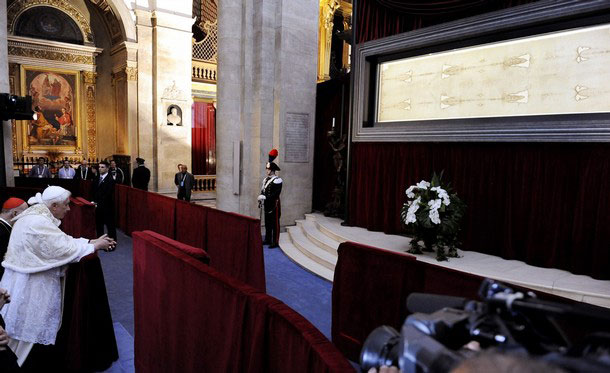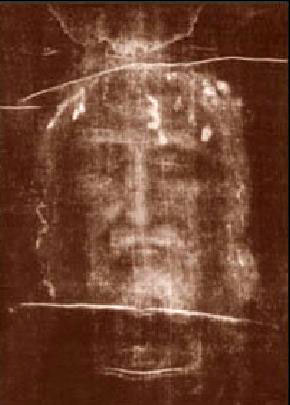"An image that everyone sees but no one can explain" — John Paul II
"It corresponds to everything that the Gospels say of Jesus" — Benedict XVI
|
|
|
A negative of the Holy Shroud |
Last May 2, Pope Benedict XVI went to Turin, Italy, to pray before the Holy Shroud, a centuries-old linen cloth that bears the image of a crucified man, a man that millions believe to be Jesus of Nazareth. (The Church says that it is not a matter of Faith, so people are free to believe or not that it is the real Shroud.) It looks as if, when Jesus resurrected, He took on a glorified body, shining with brilliant light, just like on the occasion of His Transfiguration, and this light left His imprint on the shroud. If it is really this linen that wrapped the body of Our Lord just before His Resurrection, this would be the most extraordinary artifact in history, a proof of the reality of the Resurrection of Our Lord.
So one can understand why the Holy Shroud has been the subject of hundreds of thousands of studies and researches, with the most sophisticated methods — in fact, the Holy Shroud is the most studied artefact in history. And after all those studies, no one has yet been able to explain how this image of a crucified man has been done. In fact, only Faith can explain it. Even those who came to the conclusion that the fabrics date from the fourteenth century still could not explain the fabrication of this image. For those who do not have the Faith, this piece of linen is really mind-boggling; and remains a mystery.
Here are some of the remarks Pope Benedict XVI gave today after venerating the Holy Shroud of Turin:
"I thank God for the gift of this pilgrimage, and also for the opportunity to share with you a brief meditation, which was suggested to me by the title of this solemn exhibition: "The Mystery of Holy Saturday." One could say that the Shroud is the icon of this mystery, the icon of Holy Saturday. It is in fact a winding sheet, which covered the corpse of a man who was crucified, corresponding to everything that the Gospels say of Jesus, who was crucified about noon and died at about 3 in the afternoon. (…)

Pope Benedict XVI praying before the Shroud.
"This face, these hands and these feet, this side, this whole body speaks, it is itself a word that we can hear in silence. How does the Shroud speak? It speaks with blood, and blood is life! The Shroud is an icon written in blood; the blood of a man who has been scourged, crowned with thorns, crucified and wounded in his right side. Every trace of blood speaks of love and of life. Especially that large mark near the side, made by blood and water that poured copiously from a great wound caused by a Roman spear, that blood and that water speak of life. It is like a spring that speaks in silence, and we can hear it, we can listen to it, in the silence of Holy Saturday.
"Dear friends, let us praise the Lord always for his faithful and merciful love. Departing from this holy place, we carry in our eyes the image of the Shroud, we carry in our heart this word of love, and we praise God with a life full of faith, of love and of charity."
Pope John Paul II
The Holy Shroud is a "challenge to our intelligence," an "image that everyone sees but no one can explain," a mystery that is a subject for deep meditation, and an extraordinary token of the love of God for us. Pope John Paul II had also prayed in front of the Shroud of Turin on May 24, 1998. Here are some excerpts from what he said on that occasion:
|
|
|
The face of Jesus
obtained by NASA in |
"The Shroud is a challenge to our intelligence. It first of all requires of every person, particularly the researcher, that he humbly grasp the profound message it sends to his reason and his life. The mysterious fascination of the Shroud forces questions to be raised about the sacred Linen and the historical life of Jesus. Since it is not a matter of Faith, the Church has not specific competence to pronounce on these questions. She entrusts to scientists the task of continuing to investigate, so that satisfactory answers may be found to the questions connected with this Sheet, which, according to tradition, wrapped the body of our Redeemer after He had been taken down from the Cross. The Church urges that the Shroud be studied without pre-established positions that take for granted results that are not such; she invites them to act with interior freedom and attentive respect for both scientific methodology and the sensibilities of believers. (…)
"Before the Shroud, the intense and agonizing image of an unspeakable torment, I wish to thank the Lord for this unique gift, which asks for the believer’s loving attention and complete willingness to follow the Lord. (...)
"For the believer, what counts above all is, that the Shroud is a mirror of the Gospel. In fact, if we reflect on the sacred Linen, we cannot escape the idea that the image it presents has such a profound relationship with what the Gospels tell of Jesus’ passion and death, that every sensitive person feels inwardly touched and moved at beholding it. Whoever approaches it is also aware that the Shroud does not hold people’s hearts to itself, but turns them to Him, at whose service the Father’s loving providence has put it. Therefore, it is right to foster an awareness of the precious value of this image, which everyone sees and no one at present can explain. For every thoughtful person it is a reason for deep reflection, which can even involve one’s life.
"The Shroud is thus a truly unique sign that points to Jesus, the true Word of the Father, and invites us to pattern our lives on the life of the One who gave Himself for us. (...)
An image of God’s love
|
|
|
How Christ was buried in
the Shroud, |
"The Shroud is also an image of God’s love as well as of human sin. It invites us to rediscover the ultimate reason for Jesus’ redeeming death. In the incomparable suffering that it documents, the love of the One who ‘so loved the world that he gave his only Son’ (Jn 3:16) is made almost tangible and reveals its astonishing dimensions. In its presence believers can only exclaim in all truth: ‘Lord, you could not love me more,’ and immediately realize that sin is responsible for that suffering: the sins of every human being.
"As it speaks to us of love and sin, the Shroud invites us all to impress upon our spirit the face of God’s love, to remove from it the tremendous reality of sin. Contemplation of that tortured Body helps contemporary man to free himself from the superficiality of the selfishness with which he frequently treats love and sin. Echoing the word of God and centuries of Christian consciousness, the Shroud whispers: believe in God’s love, the greatest treasure given to humanity, and flee from sin, the greatest misfortune in history. (...)
"This icon of Christ abandoned in the dramatic and solemn state of death, which for centuries has been the subject of significant representations, and for 100 years, thanks to photography, has been so frequently reproduced, urges us to go to the heart of the mystery of life and death, to discover the great and consoling message it has left us. The Shroud shows us Jesus at the moment of his greatest helplessness, and reminds us that in the abasement of that death lies the salvation of the whole world. The Shroud thus becomes an invitation to face every experience, including that of suffering and extreme helplessness, with the attitude of those who believe that God’s merciful love overcomes every poverty, every limitation, every temptation to despair.
"May the Spirit of God, who dwells in our hearts, instill in everyone the desire and generosity necessary for accepting the Shroud’s message and for making it the decisive inspiration of our lives. Soul of Christ sanctify me, Body of Christ save me, Passion of Christ console me, in Your wounds hide me." (End of Pope John Paul II’s meditation.)


